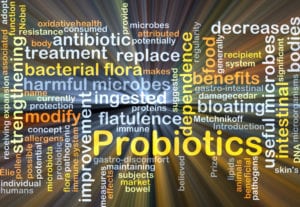Written by Joyce Smith, BS. Both in vitro cell and in vivo mouse models demonstrate the ability of Lactobacillus plantarum CCFM639 to bind with intestinal aluminum and significantly strengthen the intestinal barrier and reduce oxidative stress and inflammation.
 Aluminum, the most abundant metal in the earth’s crust 1 can access our bodies through our food and environment 2. Excessive amounts accumulate in most body tissues, including brain, liver, kidneys, spleen and bone, and may contribute to Alzheimer’s disease, dialysis encephalopathy, microcytic anemia, and osteomalacia. 3 Forty percent of all ingested Al accumulates in the intestinal mucosa 4,5 where it induces oxidative stress and intestinal inflammation 2,6, damages tight junction (TJ) proteins, and impairs the intestinal barrier function, causing cell death and increasing intestinal tract permeability 2. The European Food Safety Authority (EFSA) guideline for levels of aluminum exposure is 1mg/kg-bw/week 7. A previous study by Yu et al demonstrated that Lactobacillus plantarum CCFM639 could decrease the Al accumulation in tissues of mice by its enhanced ability to bind aluminum and its antioxidative capabilities. 8,9.
Aluminum, the most abundant metal in the earth’s crust 1 can access our bodies through our food and environment 2. Excessive amounts accumulate in most body tissues, including brain, liver, kidneys, spleen and bone, and may contribute to Alzheimer’s disease, dialysis encephalopathy, microcytic anemia, and osteomalacia. 3 Forty percent of all ingested Al accumulates in the intestinal mucosa 4,5 where it induces oxidative stress and intestinal inflammation 2,6, damages tight junction (TJ) proteins, and impairs the intestinal barrier function, causing cell death and increasing intestinal tract permeability 2. The European Food Safety Authority (EFSA) guideline for levels of aluminum exposure is 1mg/kg-bw/week 7. A previous study by Yu et al demonstrated that Lactobacillus plantarum CCFM639 could decrease the Al accumulation in tissues of mice by its enhanced ability to bind aluminum and its antioxidative capabilities. 8,9.
In this current study 10, the same authors hypothesized that the CCFM639 strain of Lactobacillus could reduce Al absorption and protect intestinal health by initially binding intestinal Al, thereby protecting the tight junction proteins and strengthening the intestinal barrier, reducing oxidative stress, and regulating the inflammatory response in both cell and animal models of aluminum-induced injury.
The results of the in vitro assay revealed that both the intervention and therapy treatments of Lactobacillus plantarum CCFM639 significantly alleviated Al-induced toxicity in the human cell line HT-29 and protected the disruption of tight junctions in the cell monolayers (p<0.05).
In the mouse model, forty C57BL6L mice were divided into four groups: an Al only group; an AL + CCFM639 group; an AL + deferiprone (a metal chelator); and a control group (CCFM639 only). Al was added to the animals’ drinking water at a dose of 200 mg /L of Al ions; CCFM639 was given at a dose of 1×109 CFU; and DFP in a 0.2ml dose at 2.5 gms/L.
L. Plantarum CCFM639 treatment was found to significantly alleviate oxidative stress in the intestinal tract, regulate the function of the intestinal mucosal immune system, restore the integrity of tight junction proteins and maintain intestinal permeability (p<0.05 for all). Although both L. plantarum CCFM639 and DFP showed similar Al binding ability in the intestine, Al was superior to DFP in decreasing Al absorption and maintaining gut health due to its enhanced antioxidative and anti-inflammatory activities.
This study demonstrates that L. plantarum CCFM639 can protect against Al-induced gut injuries by reducing intestinal epithelial cell cytotoxicity, maintaining the integrity of TJ proteins, modulating inflammation and alleviating oxidative stress in both cell and animal models. The authors suggest that L. plantarum CCFM639 may have a potential use as a probiotic in fermented foods by protecting gut health against oral Al exposure.
Source: Yu, Leilei, Qixiao Zhai, Fengwei Tian, Xiaoming Liu, Gang Wang, Jianxin Zhao, Hao Zhang, Arjan Narbad, and Wei Chen. “Potential of Lactobacillus plantarum CCFM639 in protecting against aluminum toxicity mediated by intestinal barrier function and oxidative stress.” Nutrients 8, no. 12 (2016): 783.
© 2016 by the authors; licensee MDPI, Basel, Switzerland. This article is an open access article distributed under the terms and conditions of the Creative Commons Attribution (CC-BY) license (http://creativecommons.org/licenses/by/4.0/)
Click here to read the full text study.
Posted March 11, 2019.
Joyce Smith, BS, is a degreed laboratory technologist. She received her bachelor of arts with a major in Chemistry and a minor in Biology from the University of Saskatchewan and her internship through the University of Saskatchewan College of Medicine and the Royal University Hospital in Saskatoon, Saskatchewan. She currently resides in Bloomingdale, IL.
References:
- Nayak P. Aluminum: impacts and disease. Environmental research. 2002;89(2):101-115.
- De Chambrun GP, Body-Malapel M, Frey-Wagner I, et al. Aluminum enhances inflammation and decreases mucosal healing in experimental colitis in mice. Mucosal immunology. 2014;7(3):589.
- Becaria A, Campbell A, Bondy S. Aluminum as a toxicant. Toxicology and Industrial Health. 2002;18(7):309-320.
- Cunat L, Lanhers M-C, Joyeux M, Burnel D. Bioavailability and intestinal absorption of aluminum in rats. Biol Trace Elem Res. 2000;76(1):31-55.
- Powell J, Ainley C, Evans R, Thompson R. Intestinal perfusion of dietary levels of aluminium: association with the mucosa. Gut. 1994;35(8):1053-1057.
- Sharma DR, Wani WY, Sunkaria A, et al. Quercetin protects against chronic aluminum-induced oxidative stress and ensuing biochemical, cholinergic, and neurobehavioral impairments in rats. Neurotoxicity research. 2013;23(4):336-357.
- Aguilar F, Autrup H, Barlow S, et al. Safety of aluminium from dietary intake scientific opinion of the panel on food additives, flavourings, processing aids and food contact materials (AFC). EFSA J. 2008;754:1-34.
- Yu L, Zhai Q, Liu X, et al. Lactobacillus plantarum CCFM639 alleviates aluminium toxicity. Applied microbiology and biotechnology. 2016;100(4):1891-1900.
- Yu L, Zhai Q, Yin R, et al. Lactobacillus plantarum CCFM639 alleviate trace element imbalance-related oxidative stress in liver and kidney of chronic aluminum exposure mice. Biol Trace Elem Res. 2017;176(2):342-349.
- Yu L, Zhai Q, Tian F, et al. Potential of Lactobacillus plantarum CCFM639 in protecting against aluminum toxicity mediated by intestinal barrier function and oxidative stress. Nutrients. 2016;8(12):783.
